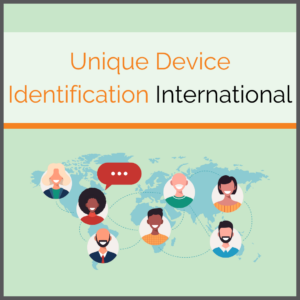
In 2017, the European Commission launched the MDR and thus also the Unique Device Identification (UDI). Europe is not alone in this. The concern to make medical technology products safer is also being implemented in other countries. Corresponding initiatives are either being worked on or are in the planning phase.
The WHO and other organizations have been working for some time on the standardization of regulations concerning the safety of medical technology products. As early as 2013, the International Medical Device Regulatory Forum (IMDRF) published a framework with the aim of standardizing regulations for UDI internationally.
The framework conditions of the IMDRF
– A Unique Device Identifier (UDI) at each packaging level according to international standards
– UDI consists of Device Identifier (DI) and Product Data (PD), such as batch number or expiration date
– UDI is machine-readable and human-readable on the label
– Data is maintained in a central UDI database
Similar to tracking drugs, the introduction of unique identification systems for medical technology products is not only underway in Europe and the USA. Many other countries are also looking for solutions. In Brazil, the regulations will only apply to hip and knee implants and stents (heart). India wants to introduce a comprehensive UDI as of 2022.
Starting next year, the voluntary program will also become mandatory in Taiwan and Saudi Arabia. In South Korea, the UDI will be introduced by 2022, similar to Europe’s tiered risk classes. China is currently working on a pilot project which is supposed to run until July 2020. Turkey, Russia, and Australia are also working on similar systems or are already implementing them.
Edit 21.04.2021: The pilot project in China has already ended. Since January 2021, the first group of medical devices must be equipped with a Unique Device Identifier (UDI) by default. If a product is newly registered with the National Medical Products Administration (NMPA), or if the registration is renewed or changed, a UDI-DI must be stored in the system. The first group includes absorbable sutures, catheters, implantable pacemakers, knee prostheses, vascular stents, and others. The GS1 acts as a qualified issuing authority for UDI in China, as well as in the EU and the USA.
Lack of unity makes things complicated
Other countries, on the other hand, have introduced systems for the identification of medical technology products. Their benefits are not concentrated on patient safety and post-market surveillance, but focus on traceability. In systems like this, the product’s entire life cycle is tracked. These include Japan, the United Kingdom, and Argentina. The latter has only introduced traceability for implants.
One can see that there are many variants of using the UDI internationally. Despite the IMDRF, the systems and, above all, the concrete designs are very different. This creates hurdles that affect the international applicability of medical technology.
UDI internationally: Example Code
A 2D data matrix code can hold more data in a smaller space. However, it also needs other scanners than a linear barcode. This poses problems for the last scanning instance, for example for hospitals. They may have to adapt to different codes. Manufacturers, on the other hand, must provide different versions of their data sets for different markets. This information has to be fed into various databases.
In the USA and Turkey, information on MRI compatibility is required. In Turkey, a distinction is only necessary between “yes” and “no”, but in the US a distinction is made between “secure”, “insecure”, and “conditionally secure”. Although the same product attributes are queried here, the concrete design of the data is different.
A solution for global demands
Overall, all systems are more or fewer blueprints based on WHO guidelines. However, the national design increases the effort for internationally operating medical technology manufacturers. If the manufacturers want to react flexibly to new requirements in the future and act compliantly on a global level, a simple database is not enough. The above-mentioned obstacles must be taken into account in the software.
A smart solution provides insight into the information a medical technology manufacturer must keep on file for each product. Additionally, it shows which business partners must sign permission in the database to guarantee actuality and accuracy. Besides, it must be ensured that the data for the product’s entire service life is always up-to-date. This includes synchronization with the corresponding national database. Also, a workflow is required to ensure that data collection and synchronization also take place “internally” between the business partners involved (contract manufacturers, marketing authorization holders, etc.) and their systems, so that the data stored in EUDAMED, for example, also correspond to the printed information on the packaging. These are all factors that can easily be overlooked because medical technology manufacturers are busy until the deadline of 2021 mainly with the (re-) approval of their products. Nevertheless, they should not forget this important aspect.